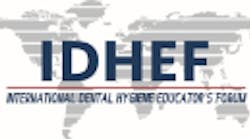By Maria Perno Goldie, RDH, MS
The Third International Dental Hygiene Educator’s Forum was hosted in Long Beach, Calif., on March 17. This article will review some of the information presented at the meeting.
JoAnn R. Gurenlian, RDH, MS, PhD, presented a discussion titled, Integrating Evidence-Based Care into Clinical Practice. I am providing excerpts from this course, with permission. Dr. Gurenlian stated that as scientific evidence keeps changing, and as educators, we must teach the latest information to our students.
Dr. Gurelian posed the following questions:
- What do we do when we don’t necessarily like or embrace the evidence?
- How do we prepare students to face the challenge of new information that conflicts with what we learned?
- Are we successfully teaching students to adapt to change for lifelong careers as evidence based practitioners?
She gave examples of evidence that may cause some controversy or concern, such as “to floss or not to floss.” The studies presented showed weak, very unreliable evidence or lack of scientific evidence to support routine interproximal flossing as an adjunct to manual tooth brushing when reducing plaque and gingivitis scores. For dental decay, results showed that flossing was only effective in reducing the risk of interproximal caries when applied professionally.
Left to right: Maria Perno Goldie, Robyn Watson, and JoAnn Gurenlian
Dr. Gurenlian also presented information on what our dental hygiene textbooks are teaching about flossing. The Wilkins textbook states that dental floss is most effective when interdental papillae are present and there has not been loss of attachment with root surface exposure, with no discussion of evidence. The Darby and Walsh textbook states that dental floss is the most frequently recommended product for cleaning proximal tooth surfaces with normal gingival contour and embrasure spaces. It does discuss some evidence under the section “benefits of flossing.” The Kearny and Goldie textbook discusses benefits and disadvantages of flossing, presents benchmark studies on the effectiveness of flossing. It summarizes with the notion that dental hygiene professional’s should determine, on an individual basis, whether high-quality flossing is an achievable goal, and recommend accordingly rather than by routine.
Dr. Gurenlian also discussed dental hygiene diagnosis (DHDx) and the dental hygiene process of care. Dental hygiene diagnosis was defined as “Identification of an individual’s health behaviors, attitudes, and oral health care needs for which a dental hygienist is educationally qualified and licensed to provide.” It requires evidence-based critical analysis and interpretation of assessments to reach conclusions about the patient’s dental hygiene treatment needs. It provides the basis for the dental hygiene care plan.
Again, the question was raised about how the current dental hygiene textbooks discuss these topics. The Wilkins textbook defines DHDx as “The identification of an existing or potential oral health problem that a dental hygienist is qualified and licensed to treat.” It includes models of DHDx, provides several examples and links them to probable etiology or risk factors, and relates DHDx to problems or solutions that can be addressed within the dental hygiene scope of practice. It does not teach how to formulate a DHDx.
The Darby and Walsh textbook focuses on human needs deficits within the scope of dental hygiene practice. It presents the DHDx as a statement of problem (unmet human need) related to statement of cause/etiology, as evidenced by statement of signs and symptoms. Dr. Gurenlian gave an example of skin and mucous membrane integrity of the head and neck related to mutable and nonmutable risk factors (for example, diabetes, smoking, and oral biofilm accumulation), as manifested by moderate gingival bleeding and periodontal probing depths of 5-7 mm. The goal would be to seek care from a periodontist, and it recommends explaining the DHDX so that the client understands the condition or problem and how it can best be resolved.
And, finally, the Kearny and Goldie textbook. The definition of DHDx “is the identification of an existing or potential oral health problem that a dental hygienist is educationally qualified and licensed to treat.” It links DHDx to assessment and a four-pronged approach to the treatment plan, and teaches how to formulate a DHDx. The text provides case study examples with diagnoses for general and oral health, and uses common terminology that is readily understandable by health-care providers.
Another question posed was: how do we, as educators, support a framework of change? Dr. Gurenlian suggested that educators use textbooks cautiously, and teach students to search the literature and read and interpret systematic reviews and meta-analyses. They should create assignments that encourage debate about hot topics, and challenge students and colleagues to explore options beyond tradition and “what we have always done.” Educators should create a climate of discovery and innovation, and practice open-mindedness, and how to say “How can we make that happen?” vs. “We can’t do that,” or “That’s not the way we do that here.”
Left to right: Ann Battrell, Tami J. Grzesikowski, Robyn Watson
A panel discussion featured Ann Battrell, MSDH, CEO, of the American Dental Hygienists’ Association; Tami J. Grzesikowski, RDH, MEd, former senior director for allied dental education at American Dental Education Association; and Robyn Watson, RDH, BSc, MPA, president of the International Federation of Dental Hygienists.
The panel members were tasked with the following questions:
- What is the role of accreditation in entry level dental hygiene around the globe?
- Do we want to investigate a minimal educational requirement for dental hygiene around the world?
- How is dental hygiene education and practice responding to access to care issues around the world?
- What group(s) should take responsibility for implementing any suggestions or ideas generated from the IDHEF?
These and other issues were discussed and debated. As the IDHEF is a meeting and not an organization, existing or new groups would need to implement policy round the above questions.
Sylvia Fresmann and I want to thank all the sponsors (Philips Sonicare, Dentsply Sirona, Colgate, and P&G), the speakers, and the participants that made this meeting a success. We encourage you to visit the Facebook page. We are investigating venues for the fourth IDHEF. Stay tuned!
Maria Perno Goldie, RDH, MS is co-founder of the International Dental Hygiene Educator’s Forum, and co-editor of the textbook Dental Hygiene: Applications to Clinical Practice. She was President of ADHA 1997-98 and President of the IFDH 2010-2013. She can be reached at: [email protected].









